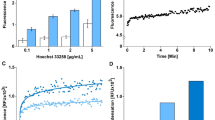Abstract
To examine the morphological changes of HL-60 cells undergoing apoptosis, we induced apoptosis by etoposide treatment, and compared the findings obtained with an electron microscopic cytochemical method with those obtained with in situ end-labeling (ISEL) of DNA and a DNA fragmentation assay. Apoptotic cells were detected by ISEL of DNA 1h before the ladder formation in the DNA fragmetation assay, and an accumulation of DNA was observed simultaneously around the nucleoli and nuclear membrane by DNA-staining electron microscopy. These findings revealed that the apoptosis-related changes occurred in the DNA before the appearance of ladder formation. DNA staining with osmium ammine B revealed, at higher magnification, a rough fiber formation of DNA before apoptosis and an accumulation of small particles with the course of apoptosis. The number of primary granules stained for peroxidase in the cytoplasm decreased as apoptosis progressed. An examination by the periodic acid-thiocarbohydrazide-silver proteinate (PA-TCH-SP) method revealed in number after the induction of apoptosis. Thus, apoptosis-related changes were observed not only in the nucleus but also in the cytoplasm.
Similar content being viewed by others
References
Kerr JFR, Wyllie AH, Currie AR (1972) Apoptosis; a basic biological phenomenon with wideranging implications in tissue kinetics. Br J Cancer 26:238–257
Arends MJ, Wyllie AH (1991) Apoptosis: mechanisms and roles in pathology. Int Rev Exp Pathol 32:223–254
Kurumada H, Kurosawa H, Sugita K, Furukawa T (1995) Morphological changes in apoptosis HL-60 cells treated with anti-FAS and interferon-γ studied by time-lapse video. Dokkyo J. Med Sci 22:73–83
Wyllie AH (1980) Glucocorticoid-induced thymocyte apoptosis is associated with endogenous activation. Nature 284:555–556
Kaufmann SH (1989) Induction of endonucleolytic DNA cleavage in human acute myelogenous leukemia cells by etoposide. campototheein, and other cytotoxic anticancer drugs: a cautionary note. Cancer Res 49:5870–5878
Cohen GM, Sun X-M, Snowden RT, Dinsdale D, Skilleter DN (1992) Key morphological features of apoptosis may occur in the absence of internucleosomal DNA fragmentation. Biochem J 286:331–334
Iseki S (1986) DNA strand breaks in rat tissue as detected by in situ nick translation. Exp. Cell Res 167:311–326
Wijsman JH, Jonker RR, Keijzer R, Van de Velde, CJH, Cornelisse CJ, Dierendonck JHV (1993) A new method to detect apoptosis in paraffin section: in situ end-labeling of fragmented DNA. J Histochem Cytochem 41:7–12
Mundle S, Iftikhar A, Shetty V, Dameron S, Wright-Quinones V, Marcus B, Loew J, Gregory S, Raza A (1994) Novel in situ double labeling for simultaneous detection of proliferation and apoptosis. J. Histochem Cytochem 42:1533–1537
Nicoletti J, Migliorati G, Pagliacci MC, Grignani F, Riccardi C (1991) A rapid and simple method for measuring thymocyte apoptosis by propidium iodide staining and flow cytometry. J Immunol Methods 139:271–279
Vitale M, Zamai L., Mazzotti G, Cataldi A, Falcieri E (1993) Differential kinetics of propidium iodide uptake in apoptotic and necrotic thymocytes. Histochemistry 100:223–229
Olins AL, Moyer BA, Kim SH, Allison DP (1989) Synthesis of a more stable osmium ammine electron-dense DNA stain. J Histochem Cytochem 37:395–398
Thiéry JP (1967) Mice en évidence des polysaccharides sur coupes fines en microscopie électronique. J. Microse 6:987–1018
Parmley RT, Eguchi M, Spicer SS, Alavareze CJ, Austin RL (1980) Ultrastructural cytochemistry and radioatography of complex carbohydrates in heterophil granulocytes from rabbit bone marrow. J Histochem Cytochem 28:1067–1089
Maniatis T, Fritsch EF, Sambrook J (1982) Molecular cloning: a laboratory manual, Cold Spring Harbor Laboratory, Cold Spring Harbor, NY. pp 280–281
Long BH, Musial ST, Brattain MG (1984) Comparison of cytotoxicity and DNA breakage activity of congeners of podophyllotoxin inecluding vp16-213 and VM26:a quantitative structure-activity relationship. Biochemstry 23:1183–1188
Ritke MR, Rusna IM, Lazo JS, Allan WP, Dive C, Heer S, Yalowich JC (1994) Differential induction of etoposide-mediated apoptosis in human leukemia HL-60 and K562 cells. Mol Pharmacol 46:605–611
Falcieri E, Zamai L, Santi S,Cinti C, Gobbi P, Bosco D, Cataldi A, Betts C, Vitale M (1994) The behavicur of nuclear domains in the course of apotosis. Histochemistry 102:221–231
Wyllie AH, Kerr JFR, Curri AR (1980) Cell death: the significance of apoptosis. Int Rev Cytol 58:251–306
Gavrieli Y, Sherman Y, Ben-Sasson SA (1992) Identification of programmed cell death in situ via specific labeling of nuclear DNA fragmentation. J Cell Biol 119:493–501
Ackerman GA, Clark MA (1971) Ultrastructural localization of peroxidase activity in normal human bone marrow cells. Z Zellforsch Mikrosk Anat 117:463–475
Traweek ST, Liu J, Brazie RM, Johnson RM, Brynes RK (1995) Detection of myeloperoxidase gene expression in minimally differentiated entiated acute myelogenous leukemia (AML-MO) using in situ hybridization. Diagn Mol Pathol 4:212–219
Austin GE, Zhao W-G, Zhang W, Austin ED, Findley HW, Murtagh JJ Jr (1995) Identification and characterization of the human myeloperoxidase promoter. Leukemia 9:848–857
Seligman AM, Hanker JS, Wasserking H, Dmochowski H, Katzoffe L (1965) Histochemical demonstration of some oxidized macromolecules with thiocarbohydrazde (TCH), thiosemicarbozide (TSC) and osmium tetroxide. J Histochem Cytochem 13:629–639
Sakakibara II, Eguchi M (1985) Ultrastructural cytochemistry of glycoconjugates in basophils from humans and animals. Histochemistry 83:307–313
Dini L, Coppola S, Ruzittu MT, Ghibelli L (1996) Multiple pathways, for apoptosis nuclear fragmentation. Exp Cell Res 223:340–347
Tomei LD, Shapiro JP, Cope FO (1993) Apoptosis in C3H/10T1/2 mouse embryonic cells: evidence for internucleosomal DNA modification in the absence of double-strand eleavage. Proc Natl Acad Sci USA 90:853–857
Jacobson MD, Burne JF, Raff MC (1994) Programmed cell death and Bel-2 protection in the absence of a nucleus. EMBO J 13:1899–1910
Author information
Authors and Affiliations
Rights and permissions
About this article
Cite this article
Mikami, T., Kurosawa, H. & Eguchi, M. Fine structure and cytochemistry of human leukemia HL-60 cells during etoposide-induced apoptosis. Med Electron Microsc 31, 16–23 (1998). https://doi.org/10.1007/BF01547944
Received:
Accepted:
Issue Date:
DOI: https://doi.org/10.1007/BF01547944




